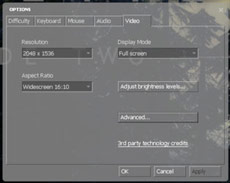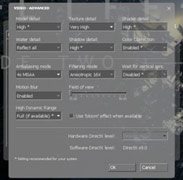HIS (AMD) ATI Radeon HD 4830 512MB
Written by Tim Smalley
October 30, 2008 | 09:17
Tags: #4830 #benchmark #benchmarks #gpu #graphics-card #load #performance #power-consumption #radeon #tested #testing

Half Life 2: Episode Two
Publisher: ValveAs one part of our game of the year 2007, Half-Life 2: Episode Two set a new high in narrative and gameplay for the series. Using Valve's widely used, albeit not overly hardware intensive, Source engine that also features as a part of legendary games like Counter-Strike, Team Fortress 2 and Portal, we were keen to feature its performance here too.
The Source engine is the most scalable engine we test. While it still supports only DirectX 9.0, it features effects like dynamic lighting with HDR effects, motion blur, advanced Havok Physics and high model details.
Episode Two took Half-Life outside into large open environments for the first time and we test with Gordon running through a large open level that combines forest and houses, with explosions and physics.
All in game detail settings are set to their highest levels, with HDR enabled, and for anti-aliasing MSAA was used where both settings were set from inside the game.
Half-Life 2: Episode Two
1680x1050 4xAA, 16xAF, DX9, Maximum Detail
- ATI Radeon HD 4870 X2
- Nvidia GeForce GTX 280
- Nvidia GeForce GTX 260+
- ATI Radeon HD 4870 1GB
- Nvidia GeForce GTX 260
- ATI Radeon HD 4870 512MB
- ATI Radeon HD 3870 X2
- ATI Radeon HD 4850
- Nvidia GeForce 9800 GTX+
- ATI Radeon HD 4830
- Nvidia GeForce 8800 GT
-
-
157.0
-
-
-
147.0
-
-
-
137.0
-
-
-
133.0
-
-
-
131.0
-
-
-
131.0
-
-
-
115.0
-
-
-
107.0
-
-
-
105.0
-
-
-
93.0
-
-
-
86.0
-
0
25
50
75
100
125
150
175
Frames Per Second
-
Average
Half-Life 2: Episode Two
1680x1050 8xAA, 16xAF, DX9, Maximum Detail
- ATI Radeon HD 4870 X2
- Nvidia GeForce GTX 280
- ATI Radeon HD 4870 1GB
- ATI Radeon HD 4870 512MB
- Nvidia GeForce GTX 260+
- ATI Radeon HD 3870 X2
- Nvidia GeForce GTX 260
- ATI Radeon HD 4850
- ATI Radeon HD 4830
- Nvidia GeForce 9800 GTX+
- Nvidia GeForce 8800 GT
-
-
156.0
-
-
-
129.0
-
-
-
123.0
-
-
-
120.0
-
-
-
113.0
-
-
-
106.0
-
-
-
106.0
-
-
-
97.0
-
-
-
85.0
-
-
-
80.0
-
-
-
63.0
-
0
25
50
75
100
125
150
175
Frames Per Second
-
Average
Half-Life 2: Episode Two
1920x1200 4xAA, 16xAF, DX9, Maximum Detail
- ATI Radeon HD 4870 X2
- Nvidia GeForce GTX 280
- Nvidia GeForce GTX 260+
- ATI Radeon HD 4870 1GB
- ATI Radeon HD 4870 512MB
- Nvidia GeForce GTX 260
- ATI Radeon HD 3870 X2
- ATI Radeon HD 4850
- Nvidia GeForce 9800 GTX+
- ATI Radeon HD 4830
- Nvidia GeForce 8800 GT
-
-
148.0
-
-
-
137.0
-
-
-
124.0
-
-
-
116.5
-
-
-
115.0
-
-
-
115.0
-
-
-
99.0
-
-
-
92.0
-
-
-
90.0
-
-
-
80.0
-
-
-
72.0
-
0
25
50
75
100
125
150
Frames Per Second
-
Average
Half-Life 2: Episode Two
1920x1200 8xAA, 16xAF, DX9, Maximum Detail
- ATI Radeon HD 4870 X2
- Nvidia GeForce GTX 280
- ATI Radeon HD 4870 1GB
- ATI Radeon HD 4870 512MB
- Nvidia GeForce GTX 260+
- Nvidia GeForce GTX 260
- ATI Radeon HD 3870 X2
- ATI Radeon HD 4850
- ATI Radeon HD 4830
- Nvidia GeForce 9800 GTX+
- Nvidia GeForce 8800 GT
-
-
146.0
-
-
-
112.0
-
-
-
108.0
-
-
-
104.0
-
-
-
97.5
-
-
-
92.0
-
-
-
91.0
-
-
-
83.0
-
-
-
72.0
-
-
-
67.0
-
-
-
53.0
-
0
25
50
75
100
125
150
Frames Per Second
-
Average
Half-Life 2: Episode Two
2560x1600, 4xAA, 16xAF, DX9, Maximum Detail
- ATI Radeon HD 4870 X2
- Nvidia GeForce GTX 280
- Nvidia GeForce GTX 260+
- Nvidia GeForce GTX 260
- ATI Radeon HD 4870 1GB
- ATI Radeon HD 4870 512MB
- ATI Radeon HD 3870 X2
- Nvidia GeForce 9800 GTX+
- ATI Radeon HD 4850
- ATI Radeon HD 4830
- Nvidia GeForce 8800 GT
-
-
126.0
-
-
-
101.0
-
-
-
84.0
-
-
-
77.0
-
-
-
75.0
-
-
-
72.0
-
-
-
64.0
-
-
-
58.0
-
-
-
57.0
-
-
-
49.0
-
-
-
45.0
-
0
25
50
75
100
125
Frames Per Second
-
Average
Half-Life 2: Episode Two
2560x1600, 8xAA, 16xAF, DX9, Maximum Detail
- ATI Radeon HD 4870 X2
- Nvidia GeForce GTX 280
- ATI Radeon HD 4870 1GB
- ATI Radeon HD 4870 512MB
- Nvidia GeForce GTX 260+
- Nvidia GeForce GTX 260
- ATI Radeon HD 3870 X2
- ATI Radeon HD 4850
- ATI Radeon HD 4830
- Nvidia GeForce 9800 GTX+
- Nvidia GeForce 8800 GT
-
-
116.0
-
-
-
76.0
-
-
-
69.0
-
-
-
62.0
-
-
-
60.0
-
-
-
56.0
-
-
-
53.0
-
-
-
49.0
-
-
-
44.0
-
-
-
30.0
-
-
-
23.0
-
0
25
50
75
100
125
Frames Per Second
-
Average
When 4xAA is enabled, the Radeon HD 4830 is faster than Nvidia's GeForce 8800 GT, but slower than the GeForce 9800 GTX+; however, as soon as you turn 8xAA on, the 4830 manages to outclass even the GeForce 9800 GTX+ - a card that costs quite a bit more than it. The Radeon HD 4850 is around 15 percent faster, which fits in line with the price differential between the HIS Radeon HD 4830 and the cheapest 4850 available on the market.











Want to comment? Please log in.